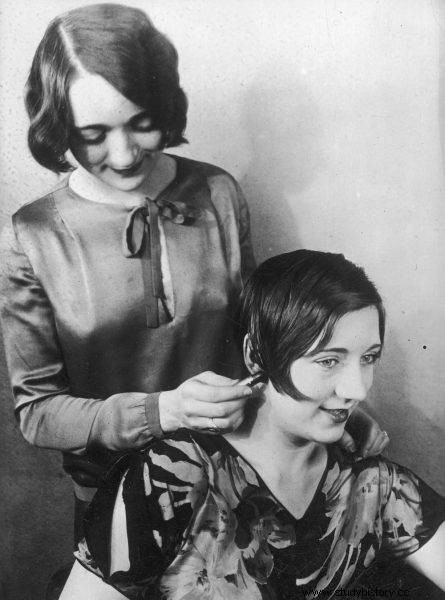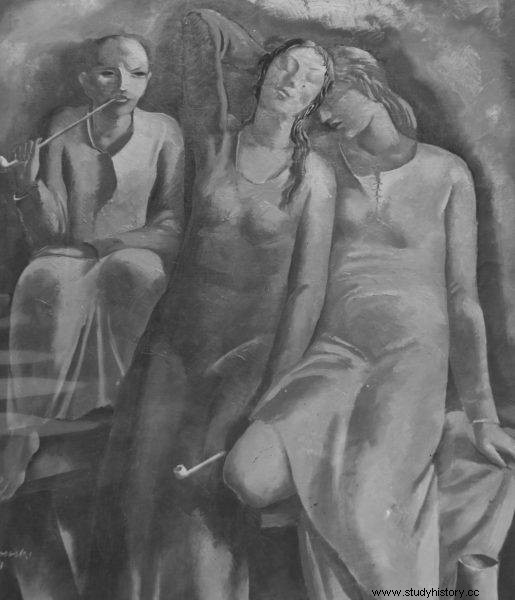Along with the lacing of the corsets, the moral standards loosened. Sex without consequences was promoted and conscious motherhood, cinemas, cafes and cabarets sprang up like mushrooms after rain. After centuries of oppression and war trauma, people just wanted to have fun. With the sounds of jazz and drug fumes ...
Admittedly, contrary to what had been announced, the global conflict was not a "war that would end all wars," but when the dust of battle settled, it turned out that it ended something else - a long era of prudishness and rigid moral principles.
The twenty years brought a real moral revolution - when the men went to the front, the women threw off the uncomfortable dresses that restrained them, rolled up their sleeves and went to work. Dennis Nothdruft explains:"In the 1920s, women's fashion became a barometer of the social and cultural changes that defined the age."
Fashionable wife
In the 1920s, the fashion world entered a new era in full swing, rejecting everything that was previously imposed on it. Karolina Żebrowska comments:“People interested in fashion after the First World War had to rub their eyes in amazement. Where are the hats heavy with bows, feathers and artificial fruit? Where did the waist accentuated for centuries disappear? ”
Heavy layers of underwear are a thing of the past. Their place was taken by simple dresses masking the waist and… just comfortable. Dresses were often made literally from a rectangle with holes for the arms and head. However, contrary to popular belief, corsets were not given up at all. After all, there was a fashion to be slim, so ladies with slightly more shape needed something to curb their curves. As Karolina Żebrowska describes:
[Corsets] no longer accentuated the waist, but helped to keep the "rollers" in check, smoothed and smoothed the figure, restraining the bust. The underwires have completely disappeared from the corsets, and rubber panels were responsible for modeling. Thinner ladies could afford to resign from a corset in favor of a T-shirt or bra that is narrow in the bust and a shorter garter belt.

Devoutly cared for long hair became a passé - instead fashionable women chose short, waved locks.
The waist was hidden, but women's legs saw the light of day. Dresses and skirts have become significantly shorter. Around 1927, frivolous outfits barely covering the knees were in fashion. Before the war, such an outfit was unthinkable! However, as Żebrowska points out:"Contrary to modern stereotypes about the 1920s, were not fashionable exposed knees or short mini-dresses for a moment. Such an outfit could only be seen on dancers during revue performances. ”
The approach to hairstyles and makeup has also changed dramatically. Long hair nurtured with devotion became passé - instead, fashionable women chose short, waved locks. They also stopped hiding behind "embarrassing" cosmetics - improving your beauty with various specifics has become even desirable.
"Parisian rubber stockings" and no strings attached
The moral revolution of the years. 20, however, reached much deeper than just women's wardrobes. It also settled in alcoves. Dresses were no longer restrictive of movement, and sex was no longer just for producing children.
The sexual initiation took place very early - psychologist Artur Aryjski conducted a study which showed that 75% of Polish 18-year-olds at the threshold of the interwar period were behind them for the first time, and 15% had started sexual activity before their 14th birthday. Sex education, orgasms, partnerships and gay marriage were discussed in a public forum.
Along with the slogans of "birth control", "conscious motherhood" and "satisfying intercourse", there was a pressing need for effective contraception. A fairly common - though illegal - method of 'avoiding trouble' was abortion. But less drastic measures were also used. The protagonist of the newest book by Nina Majewska-Brown “Florentyna i Konstanty 1916–1924. Hostages of Freedom ”describes:
When it comes to preventing pregnancy, there are several methods known (…). Konstanty does not like condoms, explaining that they take away his pleasure and are uncomfortable. All in all mu I'm not surprised, because the latest invention is far from perfect and not only condoms are uncomfortable and unpleasant for me, but they also smell like old rubber.

The text was inspired by the book by Nina Majewska-Brown “Florentyna i Konstanty 1916–1924. Hostages of Freedom ", Bellona 2021. Buy now"
Once we tried them, we both felt chafed, and the experience was closer to drama than romantic elation. Bones relieved to return to the tried and tested natural sheep intestine condoms, but putting them on has little to do with romance.
Not only that must first wet them in water, and use two for safety by putting one on top of the other, in addition, after use, check their tightness and carefully dry them, pushing them with knobs so that they do not stick together.
The instructions advised that the condom should be lubricated with animal fat - for example bacon - before sexual intercourse, which, however, could effectively suppress the appetite for bed games. There was an alternative, but that wasn't necessarily tempting either. In the novel by Nina Majewska-Brown we read:
There are also fish bladder condoms on the market but the thought of them simply disgusts me, and I vehemently opposed their use. Of the two evils, I prefer to have a piece of sheep in me rather than a slimy fish, although neither of these visions is particularly nice and encouraging.
Apparently some modern latex, as they call them, have recently appeared, "elastic bands", "condoms", "pads", "Parisian rubber stockings", "English coats" or "French letters", but due to pregnancy we have not used them yet.
Getting high on a drug
People looked for loss and a way to escape from everyday life, not only in sex, but also in drugs. Eagerly consumed by young Polish artists as early as the nineteenth century, in the interwar period, they left the salons to enter "under the thatched roofs". The scale of the problem was so large that the authorities became interested in it. Paweł Rzewuski writes:
In 1923, the anti-drugs act entered into Polish legislation. It contained the following text:"it is forbidden to manufacture, process, transport and export, store, trade and any circulation in general of raw opium, therapeutic opium, smoking opium and its waste, hashish, cocaine, heroin, all their salts and preparations. ".
Despite these efforts, drugs slowly began to enter the Polish market, and thus also to Warsaw. They became more and more popular in some areas.

People looked for distress and a springboard from everyday life not only in sex, but also in drugs.
Officially, from 100 to 300 drug addicts were treated in psychiatric institutions of the Second Polish Republic. However, it is hard to believe in the truthfulness of these estimates, since the Rzeczpospolita daily of August 15, 1929 stated that in Warsaw alone there are about 15,000 cocaine, morphinists and people addicted to ether and opium.
It was estimated that up to PLN 200,000 a day is spent on drugs in the capital , and the drug route led from Germany to Gdańsk - and on to Russia. The traders made great money on it - and it was impossible to fight them. The reporter of "Kurier Polski" reported:
Although the police know most of them, they are downright elusive. It is difficult to catch them red-handed, because they carry neither goods nor money with them. They deliver the drug in a very sophisticated and careful way, e.g. in a matchbox or in a cigarette thimble.
The public awareness of the strongly "candy" version of the life of our ancestors in the interwar period. We associate this era with elegant ladies and elegant gentlemen, sophisticated entertainment and high culture. However, the truth about the crazy 1920s is quite different. Also in Poland they were… just crazy.
Inspiration:
- N. Majewska-Brown, Florentyna and Konstanty 1916–1924. Hostages of freedom, Bellona 2021.
